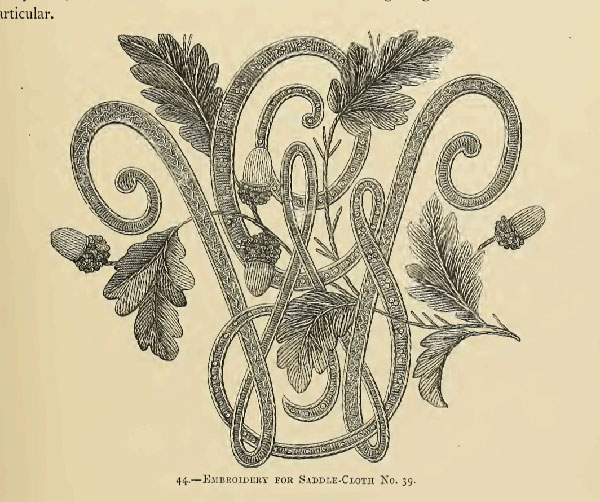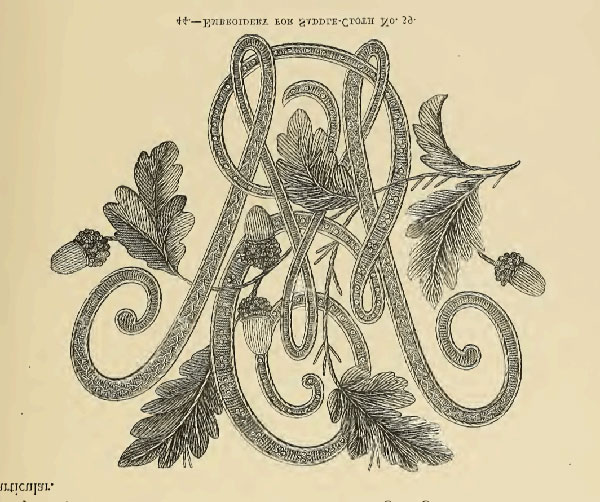Monograms are a fabulous way to embroider something very personal, whether it’s for yourself or as a gift for someone else.
Once upon a time, monograms were used primarily among upper classes to mark their household linens and other goods with a certain level of distinction and as a clear designation of ownership. A monogram (or decorative initials or ciphers – there’s a difference, and you can find an article on this point here) clearly stated, “Not only can I afford this quality fabric (or silver or porcelain or gilding or stonework or jewelry or carriage or what-have-you), but I can afford to have it artistically marked as mine so that no one can confuse it with anyone else’s.”
Hurray for you.
Today, monograms (using it as an umbrella term) are much more widely used and much more accessible, but their purpose is still clearly to mark something in a distinctive way, designating ownership or connection. Your monogram is personal. It represents you, and it says something about you and your relationship to this particular thing – even if it’s just a dish towel.

Because I’ve written a lot about embroidered monograms – I love them as individual, small, manageable projects – I get a lot of questions about them.
Often, I’m asked if I can “design a monogram.” Usually, the person asking this means a cipher – a group of intertwined letters.
I don’t really offer this kind of service, although I have done it as a favor occasionally.
Usually, I’ll start by looking for a cipher that already exists. There are loads of books and other publications out there in the public domain that feature a huge array of decorative initials, ciphers, and monograms. This book (Monograms & Ciphers by Turbayne et al.) is available, for example, on Project Gutenberg for free.
The WG with acorns and oak leaves above happens to be a cipher that I’ve had hanging around on my computer for eons. I’m not sure which publication I originally found it in, but it’s in my “public domain” folder. I’m know it’s from an old publication. I may have even written about it before (!).
I like the design of this particular cipher. I love the oak leaves and acorns. But I’m not WG. And I don’t know any WGs.
Still, I can make this cipher work for me, with a little manipulation.

The great thing about the letter W is that, at heart, it’s really just a disoriented M.
And, you know, the tail of that G, when the whole image is turned upside down, looks remarkably like a C.
At this point, I’d probably print the image and sit down with some sketching and tracing paper to play with the letters. I’d make them removable from each other. And I’d break them down into the parts I like.
I wouldn’t have to do a whole lot with the W-turned-M – it’s a nicely proportioned M as it is.
With the G, I’d break it down into parts, manipulate the tail, and reconstruct it into a C that would probably retain some decorative swirls.
I’d adjust the placement of the leaves and acorns into embellishments that fit with my new letter parts. All the while, if my purpose is embroidery, I’d be thinking of how I’d embroidery the various elements.
I could also do some of this work on the computer, using a program like Adobe Illustrator or Inkscape. If I turn the cipher into a vector line drawing, I can break down the whole design into small parts, I can manipulate the parts fairly quickly, and I can build a new cipher just by moving around the manipulated parts.
So if you’re eager to embroider your own personal cipher or monogram, you don’t need to draw it afresh. If you’ve seen ciphers or monograms that you like in old publications – but that don’t feature your own letters – try to find similar letters and see what you can do with them.
Deconstruct and reconstruct! This is an accessible and logical way to build your own monograms using designs that already exist, regardless of your level of drawing skills.
Some great places to find public domain books and other publications featuring decorative initials, ciphers and monograms in art and lettering are Internet Archive and Project Gutenberg.







Until I read that it was a monogram I thought it was just a general, very attractive scroll based design. I am tempted to give it a go as such.
Totally non-sequiter question ….
Sometime back, when floche came out, you did a series of articles showing the sizes of various types of cotton threads from stranded to perle.
Have you ever done that with silks (flat, spun, and twists) and a single strand of DMC for comparison?
Thanks!
I haven’t done it in that way with silk, but it’s a good idea! I will put that on my list – especially lately, I’ve had a lot of questions about silk sizes in comparison to cotton. It’s hard to gauge because they’re not the same. But compared to the commonly available cottons, it would be a good visual to have. I’ll work on that!
Oh, squee!! I got my books!! Happy Birthday to me!!
My problem is far more than proper terminology. I’d guess that more times than not, I have no idea what the letters are supposed to be. All those swoops, swirls, and extra bits to connect letters and make the design balanced lead my eye astray and confuse my brain. Although maybe done in colors or with shading might be better than looking at all black & white pictures in the books? And the stitching direction lines probably help too.
And then how do you read them, left to right, left/right/center, by size (guessing the biggest letter is always the last name)?
Thanks for the links.
I’m with you—I love cyphers! Back in the day, Catherine Jordan taught an EGA class on the subject using graph paper & a selection of counted work alphabets. The needlebook I made is one of my favorite things. She might be another resource if she’s still teaching.